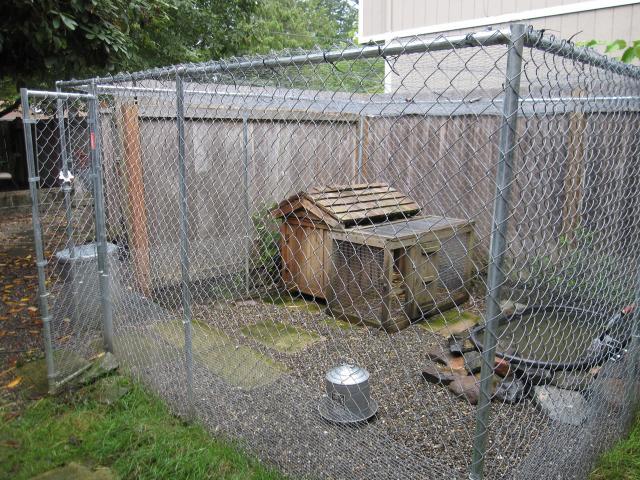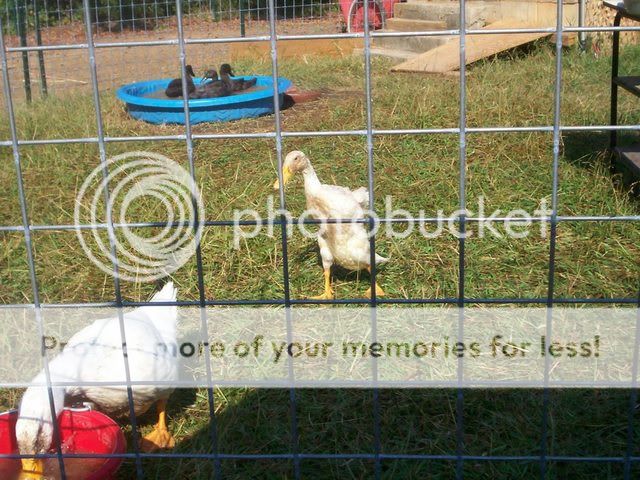I'm getting my duck area ready - what kind of fencing do you all use? I have chicken wire for my chickens and I hate it...... I have thought about hardware cloth but I can only find i 2 or 3 ft high which isn't as High as I would like it....... What do you guys suggest? I've looked through the posts of the pics of everyones and they look great and i have gotten some ideas but not sure what to use for fencing.
Navigation
Install the app
How to install the app on iOS
Follow along with the video below to see how to install our site as a web app on your home screen.
Note: This feature may not be available in some browsers.
More options
You are using an out of date browser. It may not display this or other websites correctly.
You should upgrade or use an alternative browser.
You should upgrade or use an alternative browser.
fencing material
- Thread starter davekrista
- Start date
In some areas I use 6' field fencing with a hot-wire along the top and bottom. In other areas I use electric netting.
In my small run I use regular welded wire fencing and have added the hardware cloth on the bottom. What you are trying to achieve is that nothing gets under or can reach in with their hands. Ducks love to sleep next to the fence and raccoons have been known to reach in a rip heads off. So you really don't need to go above 2 feet with the hardware cloth as long your other fence goes higher. You can then add electrical fencing on top so nothing gets over. I was planing on doing that, but never did. Nothing goes in there in the daytime and they are locked into the duck house at night. So I feel ok with that. Plus the duck house is attached to our shop right next to our bedroom window. So we can hear things, and our dogs patrol that area at night too. Well the dogs sleep in the house but they do run out through the dog door, if they hear something. The larger day pen is another story. It covers 1 acre and does not have electric fencing either. Here we can have potentially a problem with coyotes jumping in. Hasn't happened yet, but it can happen. The point is don't drive yourself crazy and thing that all predators will show up once your ducks are out. There are so many members her that free range and don't have a problem at all. It can happen, but it does not happen like crazy either. Below is a gate picture that shows the two type of wires. The boy in there fell out of the pool and injured his wing. He has healed nicely and it back to normal behavior. We also burried 12"x12" concrete pavers on their side underneath the gate so nothing can dig in there.

A picture of the small run:


A picture of the small run:

We have a chain-link dog run and we have lined the bottom 2 1/2 feet or so with welded wire. It is covered on top with chicken wire, which isn't the best, but it's worked so far. We have large rocks around the outside base of the fence and grass has grown up around them making it very difficult to move them to dig under the fence. Our ducks free-range during the daylight hours.
The small house inside the run is completely rodent-proof with 1/2" welded wire. This is to protect broody ducks and their eggs/ducklings.
We know we have raccoons that know about the ducks, since we find tracks around the run every so often. So far we haven't lost anyone with this set up.

The small house inside the run is completely rodent-proof with 1/2" welded wire. This is to protect broody ducks and their eggs/ducklings.
We know we have raccoons that know about the ducks, since we find tracks around the run every so often. So far we haven't lost anyone with this set up.

- Jun 12, 2009
- 229
- 6
- 111
dave krista you can probably special order different size hardware cloth at your local feed store, maybe even local hardware if you ask they may be able to special order. thats what i did for my chicken wire so it was high enough to my liking.
- Mar 21, 2009
- 2,229
- 52
- 349
We use several different things, but mostly welded wire. Lately, we have been ordering a lot of our wire through Ace Hardware because you can have it delivered for pick up at the nearest store, saving you the shipping which can be over a $100 for even one roll of wire.
The size and height you use just depends on so many factors. The smaller the pens, the smaller the opening need to be so that something can't reach through. If they are not covered, the fence needs to be taller. If you are doing raised cages, probably lower is better. If you want to be able to walk inside, again probably higher is better. It just depends on so many factors. I tend to like the smallest openings and the lowest gauge we can afford. Right now, I don't have any cages or runs with higher than 1 x 2 openings. To me, unless you are fencing a huge area like for a perimeter fence, the cost of the smaller openings is worth it. I have used 2 x 3 and 2 x 4 in the past and just didn't like it, unless for framed out perimeter fencing.
We, of course, have used some hot wire as well. We don't currently use any electric netting or even gamebird netting (although we have in the past, most of our cages now have welded wire roofs). We also never use chicken wire, it is just not sturdy enough. On occasion, for our larger birds' moveable pens, we use hog panels. Clearly though, you can't use those for permanent caging with no other sources of protection.
Anyway, my top pick for wire 36" inches and taller is the 16 gauge, 1 x 2 wire and my top pick for shorter than that would be the 16 gauge 1 x 1 or 1/2 x 1. For raised cages or cages small enough for something to reach inside and grab a bird, I prefer 1/2 x 1/2.
The size and height you use just depends on so many factors. The smaller the pens, the smaller the opening need to be so that something can't reach through. If they are not covered, the fence needs to be taller. If you are doing raised cages, probably lower is better. If you want to be able to walk inside, again probably higher is better. It just depends on so many factors. I tend to like the smallest openings and the lowest gauge we can afford. Right now, I don't have any cages or runs with higher than 1 x 2 openings. To me, unless you are fencing a huge area like for a perimeter fence, the cost of the smaller openings is worth it. I have used 2 x 3 and 2 x 4 in the past and just didn't like it, unless for framed out perimeter fencing.
We, of course, have used some hot wire as well. We don't currently use any electric netting or even gamebird netting (although we have in the past, most of our cages now have welded wire roofs). We also never use chicken wire, it is just not sturdy enough. On occasion, for our larger birds' moveable pens, we use hog panels. Clearly though, you can't use those for permanent caging with no other sources of protection.
Anyway, my top pick for wire 36" inches and taller is the 16 gauge, 1 x 2 wire and my top pick for shorter than that would be the 16 gauge 1 x 1 or 1/2 x 1. For raised cages or cages small enough for something to reach inside and grab a bird, I prefer 1/2 x 1/2.
Electric poultry netting. Worth every penny to protect my waterfowl.
- Mar 21, 2009
- 2,229
- 52
- 349
I have thought about using the electric netting. The only thing that has stopped me from getting it is not being able to use it in snow. I have too many birds for like extensive moveable pens. It just wouldn't be practical for much of the breeding season when the temps. are warmer. Do you use yours in inclement weather? I think I will get one for next year to use for our juvenile grow out pen. It just hasn't been necessary before now and as I said, seemed impractical for us. All of ours are kept in covered pens though and we do use hot wire in some places. I think I would also feel a little insecure in our area not having a cover of some sort over the pens, hence all of ours have welded wire roofs.
We just built a duck aviary (125x75) and used 1x2 welded wire 5.5 ft high with .5ft bent on the ground to keep things out and then ran a small .5x.5 plastic wire aroudn the whole fence to keep babies in. We are also putting up an electric fence. We have a 1.5x1.5 net over the top of it. They are picture on my blog and I can tell you what I would do different the next go round!

I used goat panels for my duck pen. When the runners were 4 weeks old they could duck and walk thru but now they are to big. The rest of the big duck yard is cattle panels and welded wire fencing down by the dogs
Similar threads
New posts New threads Active threads
-
Latest threads
-
How important is direct sunlight to chicken health?
- Started by EmmaDonovan
- Replies: 1
-
Brown leghorn rooster x light Sussex hen cross
- Started by Nateclah22
- Replies: 0
-
Need some ideas/suggestions!
- Started by CCsGarden
- Replies: 4
-
-
-
-
Threads with more replies in the last 15 days
-
Introducing TUDYBOOK - The Tudy Coloring Book Generator
- Started by Nifty-Chicken
- Replies: 70
-
Open Contest TudyBook Holiday Dreams, a Text-to-Image Contest
- Started by Debbie292d
- Replies: 46
-
-
Question of the Day - Sunday, December 21st, 2025
- Started by casportpony
- Replies: 44
-
-
×

